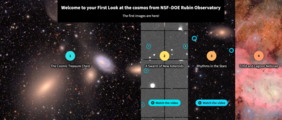On Monday, June 23, 2025, the first images from the American Vera C. Rubin Observatory were presented to the public at 5 p.m. CEST. The Astronomisches Rechen-Institut (ARI), part of the Centre for Astronomy of Heidelberg University (ZAH), and the Max Planck Institute for Astronomy (MPIA) are participating in the project and contributing to software development. Both research institutions will thus have access to the telescope's data.
Media representatives were invited that afternoon to experience the presentation of the first images at the House of Astronomy in Heidelberg and to engage in discussions with participating scientists. This event was accompanied worldwide by so-called "First Look Parties".
Observatory of Superlatives
The Vera C. Rubin Observatory, funded by the American National Science Foundation and the U.S. Department of Energy, will revolutionize our understanding of the universe. For the next ten years, the telescope will observe the visible sky from its location in Chile. The goal is to create a "time-lapse image" of the observable sky that far exceeds previous sky surveys in size and depth. The observatory was named after astronomer Vera C. Rubin, who provided the first convincing evidence for dark matter. The new sky survey is called the Legacy Survey of Space and Time (LSST) and will observe the southern sky approximately 800 times during its 10-year mission. The 8.4-meter Simonyi Survey Telescope at the Rubin Observatory is equipped with the largest sky camera ever built. But the Rubin Observatory is also the first of its kind in other respects: It sets new standards with its mirror design, camera size, sensitivity, telescope speed, and computing infrastructure. The "time-lapse recording" of the southern sky will enable the discovery of thousands of new asteroids, comets, pulsating stars, and supernova explosions, among other things, and will bring us closer to answering the greatest mysteries of modern cosmology – dark energy and dark matter.
First Look Party in Heidelberg
The release of the first images from Rubin was eagerly awaited by researchers internationally, but especially in Heidelberg. The ARI and MPIA are independent members of the LSST Discovery Alliance, an organization that unites a global network of scientists and provides resources in a variety of ways to exploit the full potential of the observations. Numerous media representatives were present at the Haus der Astronomie (HdA) during the livestream presenting the first images from Rubin, including television crews from ARD/SWR, ProSieben, and SAT1.
Scientists involved in the project initially explained the contributions of ARI and MPIA to Rubin and the research projects planned in Heidelberg using Rubin data. Afterwards, the first images from the LSST camera were transmitted and shown live in the Klaus Tschira Auditorium of HdA. Even these initial results were simply breathtaking in their beauty and wealth of information. The media response was particularly remarkable. There was no broadcaster or magazine that didn't report on the new super-observatory. Even the German news program "Tagesschau" honored Rubin and showed interview excerpts with Dr. Hundermark and Prof. Wylezalek from ARI. The magazine "Der Spiegel" reported on Rubin in several articles and also quoted ARI colleagues with their explanations of the instrument's scientific goals.
Overall, the First Look Party in Heidelberg was a major media success for astronomy in general and for the ZAH and MPIA in particular.
FURTHER INFORMATION
Vera C. Rubin Observatory
First Look Parties worldwide
SPIEGEL Article on Rubin
MPIA First Look Press Release
CONTACT FOR THE MEDIA
Dr. Guido Thimm
Centre for Astronomy of Heidelberg University (ZAH)
thimm@uni-heidelberg.de

